The
double or multiple engravings represent one of the most interesting and appealing
varieties of Naples stamps.
To understand their origin we must have clear in mind the specific system
used to prepare the printing plates for these pieces.
The original minting die of the stamp was carved in steel by hand by Masini,
the artist who was given this responsibility; once the work is finished and
some tests on paper made, the tool is ready and is tempered.
The image present on the minting die is reproduced on a soft steel cylinder
by very high pressure (Diena talks about values up to 25 tons!); it appears
in "negative" form on the cylinder (that means that the parts
in relief on the minting die appear in depression on the cylinder). Even the
cylinder is then tempered to obtain the hardest possible material.
This is the "basis" cylinder. Through it the real printing plates
are prepared.
The cylinder is rolled and pressed, by hand, on the printing plates in copper
or soft steel, so many times as the samples in the composition (200, in our
case).
This operation is extremely delicate and it was even more at that time.
Every minimal imprecision at this step was leaving its mark in definitive
way.
It was enough a small stop in the movement, a minor indecision in the execution,
a non uniform pressure, an extraneous small body that was deposited between
cylinder and plate, a slight shift, a positioning error and... the damage
was done!
Each of these inconvenients was leaving its own defect typology in the composition.
At the end of the work, all the 200 reproductions made, the composition with
all the congenital inaccuracies was tempered and ready for printing. So it
is explained why it is possible to reconstruct the plates from the samples:
each sample print is different from the other for some very minimal detail.
- - - - - - - - -
The double printings found on the Naples stamps do have this origin: a repositioning
or a shifting during the reproduction from the cylinder to the plate. For
some values are rare, for others, like the 5 Grana, relatively common. There
are of different type and extension: some are related to small parts of the
stamp or of the labels, others are more sharp and visible. They can be double,
that means with only one additional engraving on top of the original, or multiple
with several engravings close to each other.
Here are the values on which they are known:
|
1/2
Grana
|
1st
plate
|
Unknown |
|
1/2
Grana
|
2nd
plate
|
Unknown |
|
1
Grana
|
1st
plate
|
Unknown |
|
1
Grana
|
2nd
plate
|
Position 10 |
|
2
Grana
|
1st
plate
|
Different positions |
|
2
Grana
|
2nd
plate
|
Position 91 |
|
2
Grana
|
3rd
plate
|
Unknown |
|
5
Grana
|
1st
plate
|
Different positions; many multiple engravings |
|
5
Grana
|
2nd
plate
|
Unknown |
|
10
Grana
|
1st
plate
|
Different positions |
|
10
Grana
|
2nd
plate
|
Unknown |
|
20
Grana
|
1st
plate
|
Different positions |
|
20
Grana
|
2nd
plate
|
Unknown |
|
50
Grana
|
-
- -
|
Position 1 |
The most known are without doubts the ones of the 5 Grana: they are enough
common and present themselves both as large thickenings of the labels and
of the borders as well as clearly separated labels even if by not so much.
I show here 3 samples with clear double and multiple engravings (Fig. 1/4).
Pay attention not to confuse them with simple printings just slightly shifted.
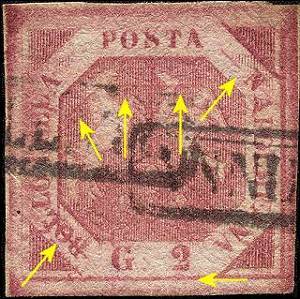
Fig. 1: 2 Grana
of the 1st plate with very sharp and extensive
double engraving shifted to the bottom
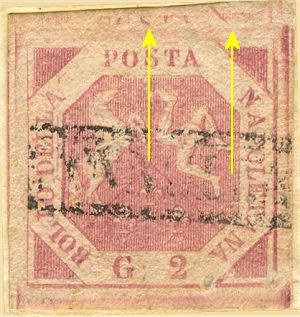
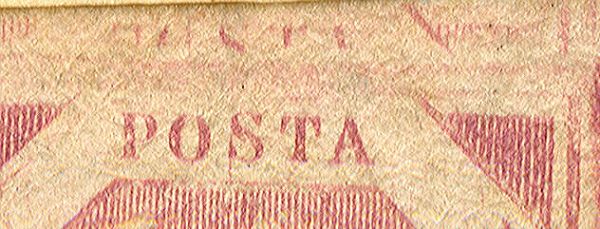
Fig. 2: Fig. 2: 2 Grana
of the 1st plate with neat upper double engraving
(normal view and magnified detail)
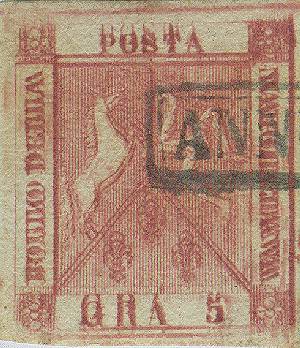
Fig. 3: 5 Grana
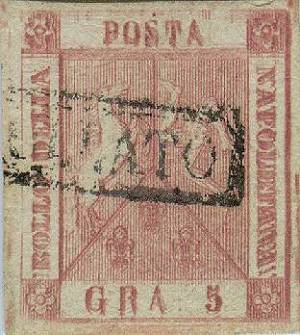
Fig. 4: 5 Grana of the 1st plate with very evident multiple engravings, shifted to the bottom